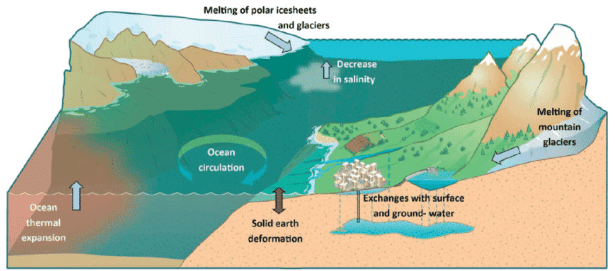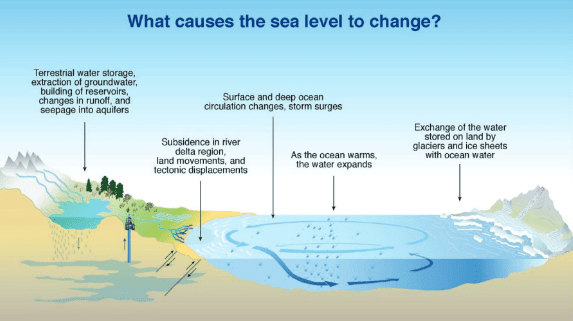Sea Level Changes | Geography Optional for UPSC PDF Download
Introduction: Sea Level Changes
- Changes in sea level refer to variations in the average height of the ocean's surface, also known as the mean sea level. These changes can be described as relative changes in sea level.
- A relative rise in sea level can occur when there is an uplift of land or ocean floor, or when both land and ocean floor are experiencing changes in elevation at the same time. In other words, the relative change in sea level is influenced by the shifting of both land and sea surfaces.

The Major Categories of Change in Sea Level are Mentioned Below
The main categories of sea level change can be summarized as follows:
- Eustatic changes: These occur when the volume of seawater changes due to factors such as global warming and melting ice sheets, which cause a rise in sea level, or ice ages, which result in a fall in sea level.
- Tectonic changes: These involve changes in the land level and can be further divided into three types:
- Isostatic changes: These happen due to the addition or removal of a load on the landmass. For example, during ice ages, the landmass subsided under the immense weight of glacial ice, leading to an apparent rise in sea level. Conversely, the landmass of Scandinavia is still rising as the glacial ice melts and is removed, causing a change in sea level.
- Epeirogenic movement: This occurs when large-scale tilting of continents takes place. As a result, one part of the continent may rise in relation to the mean sea level, while another part may subside, causing an apparent change in sea level.
- Orogenic movement: This is related to the folding and flexing (stretching) of the Earth's crust, which leads to the formation of tall mountains and an apparent decrease in sea level.
In summary, changes in sea level can be attributed to eustatic changes, which involve shifts in the volume of seawater, and tectonic changes, which involve alterations
Relevance of the study of sea-level changes
- The study of sea-level changes holds great significance for multiple reasons. Firstly, it offers crucial evidence related to climate change and allows us to establish a reference point for determining the rates of tectonic upliftment in previous geological periods. Sea level changes directly impact the rate and pattern of erosion and deposition processes in coastal regions.
- Understanding sea-level fluctuations is essential for assessing the suitability of coastal areas for industrial development. These fluctuations also dictate the availability of land, particularly in coastal regions, which hold importance for agricultural purposes. The potential submergence of land in the future could have disastrous consequences for human civilization, as it may threaten our food security.
- By predicting climate change and identifying areas that may be submerged undersea, low-lying countries can take proactive steps to construct coastal dykes and embankments. Knowledge of future sea-level rise is also crucial for mapping areas that may be affected by storm surges and periodic flooding.
- Furthermore, the identification of areas that may be submerged in the near future enables us to strategically establish tidal power generation plants in suitable locations. Overall, the study of sea-level changes is essential for informing various aspects of human civilization, from agriculture and industry to energy generation and infrastructure development.
Mechanisms of the Change in Sea-Level
- The fluctuations of sea level involve three basic mechanisms:
- changes in ocean water volume;
- changes in ocean basin volume;
- changes in the geoid, i.e., the shape of the earth changes in the volume of ocean water:
- The present sea level would rise by about 60 to 75 m if the ice in Antarctica melts, whereas the Greenland ice cap would contribute about 5 m rise in sea level.
- It is assumed that, in such a case, the added load of ocean water would lead to the sinking of the ocean floor due to isostatic compensation.
- So the total rise of sea level would be about 40-50 m. However, the isostatic adjustment of the land and the ocean is still not clear due to a lack of data.

Changes in the Volume of the Ocean Basin
Variations in the volume of ocean basins and the subsequent changes in sea level were significant events during the Mesozoic Era and the early Cenozoic Era. These changes occur due to several factors, including:- Changes in the volume of mid-ocean ridges: A key tectonic reason for sea-level rise, mid-ocean ridge volume alterations may occur due to periodic reorganization of plate boundaries, causing fluctuations in the ridge system's total length. When the lithosphere is warm, the spreading rate increases, resulting in an increase in ridge volume and vice versa. As the oceanic ridge volume increases, the sea level rises.
- Accumulation of sediments on the ocean floor: Sediments are generated by the erosion of continents and are deposited on the ocean floor. This deposition can lead to ocean floor subsidence and the removal of sediments either through subduction or upliftment. If these two factors are not considered, the sea level will rise due to the decreased volume of the ocean basin.
- Impact of orogenesis: Orogenesis results in the shortening and thickening of the continental crust and a decrease in the area of continents. Consequently, the sea level falls due to an increase in the volume of the ocean basin.
Short-Term Changes in Global Sea Level
Short-term changes typically occur within a year, with seasonal variations of 5-6 cm in sea level being common. However, sea level fluctuations of 20-30 cm or more are observed in nearly all coastal areas worldwide. Although the causes of such short-term changes are not entirely known, they may be due to a complex interaction of factors such as:
- Marine water density: The density of seawater is controlled by temperature and salinity. Low temperature and high salinity result in a higher density of seawater and a lower sea level. This is why the eastern Pacific Ocean has a sea level 30-50 cm higher than the Atlantic Ocean, due to its lower temperature and higher salinity.
- Atmospheric pressure: Low pressure results in a higher local sea level and vice versa. In areas of low pressure, the sea level rises locally because water is drawn in by the upward-moving air mass.
- Velocity of ocean currents: Fast-flowing ocean currents cause a sea-level rise on their outer fringes when taking a curved path.
- Ice formation and fall in sea level: During winter, ocean water trapped in the ice caps of the northern and southern hemispheres leads to a decrease in sea level.
- Piling up of water along windward coasts: A local rise in sea level occurs in coastal regions when water is driven towards the coasts by an air mass, such as during the monsoon months in South and East Asia.
- Additionally, the twentieth century has observed short-term global sea-level rise due to factors such as global warming caused by human activities, resulting in the thermal expansion of ocean water.
The effects of a sea-level fall include changes in the base level of rivers, rejuvenation of landforms, shoreline extension, river lengthening, coral reef death, and ice cap expansion.
Conclusion
Sea level changes are a crucial aspect of Earth's natural processes and are influenced by eustatic and tectonic factors. Understanding these changes is essential for addressing the impacts of climate change, managing coastal development, and informing various sectors of human civilization. The study of sea level changes involves analyzing mechanisms such as ocean water volume, ocean basin volume, and geoid changes. Short-term fluctuations in sea level are also significant and can result from various factors, including marine water density, atmospheric pressure, and ocean currents. As we continue to face the consequences of climate change and human activities, monitoring and understanding sea level changes becomes increasingly important for the sustainable development and adaptation of our societies.Frequently Asked Questions (FAQs) of Sea Level Changes
What are the main factors causing changes in sea level?
The main factors causing changes in sea level are eustatic changes, which involve shifts in the volume of seawater, and tectonic changes, which involve alterations in the land level. Eustatic changes occur due to factors like global warming, melting ice sheets, and ice ages, while tectonic changes involve isostatic changes, epeirogenic movement, and orogenic movement.
Why is the study of sea-level changes important?
The study of sea-level changes is important because it offers evidence related to climate change, helps determine rates of tectonic upliftment, impacts erosion and deposition processes, informs the suitability of coastal areas for development, and enables the identification of areas that may be submerged in the future. It also aids in planning for coastal protection measures, storm surge predictions, and tidal power generation.
What are the short-term changes in global sea level?
Short-term changes in global sea level typically occur within a year and can be attributed to factors such as marine water density, atmospheric pressure, velocity of ocean currents, ice formation, and piling up of water along windward coasts. Additionally, human-induced global warming has caused sea-level rise due to the thermal expansion of ocean water.
|
303 videos|636 docs|252 tests
|
FAQs on Sea Level Changes - Geography Optional for UPSC
| 1. What causes sea level changes? |  |
| 2. How do changes in the volume of the ocean basin affect sea levels? |  |
| 3. How do sea level changes impact coastal areas? |  |
| 4. Are sea level changes uniform across the globe? |  |
| 5. How can we measure and monitor sea level changes? |  |





















